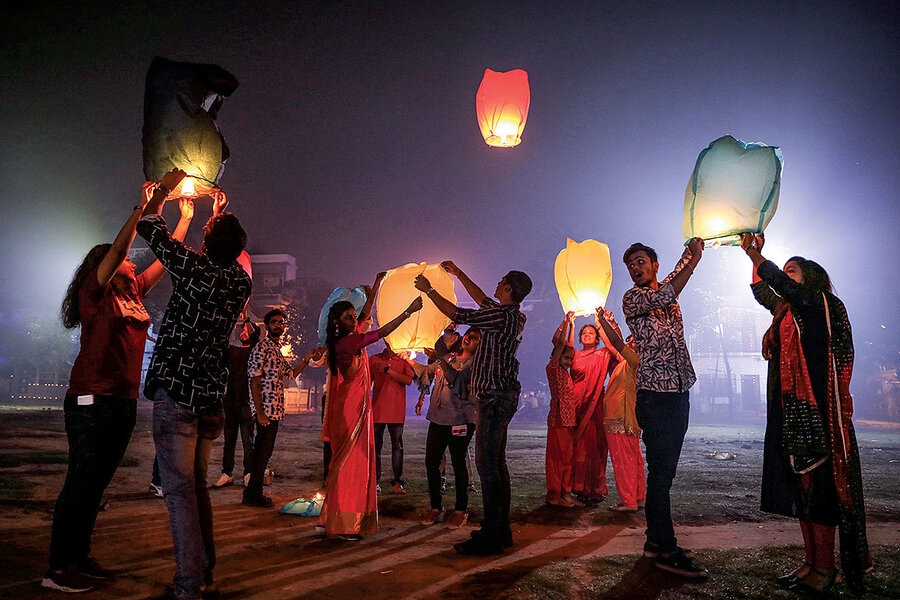Diwali: Why the Hindu Festival of Lights is spreading around the world
Loading...
Lamps light streets and fireworks illuminate the night sky with beautiful, colorful designs. Playful rangoli designs dance across floors. The smell of home-cooked sweets wafts through rooms of celebration, as families and friends come together in joy.
It’s the season of Diwali, one of the largest religious festivals in the world. Also known as the Festival of Lights, the celebration stretches back 2,500 years across South Asia.
But in recent years, Diwali has swelled in popularity worldwide, and in some cities in the United States, Diwali celebrations attract thousands of participants each year. One of the largest festivals takes place in San Antonio. In 2019, a citywide Diwali celebration drew more than 40,000 people.
Why We Wrote This
Light is a universal symbol of inspiration. Perhaps that’s why Diwali, the Hindu Festival of Lights, resonates with so many people around the world.
Awareness of its cultural importance comes as Indian American culture grows more visible in the U.S. with the election of Vice President Kamala Harris. In recent years, a number of states have formally recognized October as Hindu Heritage Month.
Part of the reason Diwali has an ability to span the globe, cultural observers say, is because at its core it offers the universal message of the power of good over evil.
Where does it come from?
Diwali is primarily observed by Hindus – the majority of whom reside in India. But different faith traditions have their own origin stories for Diwali.
North Indian Hindus celebrate the royal homecoming of Lord Rama following a victorious battle, while South Indian Hindus commemorate Lord Krishna’s defeat of a demon. Jains honor a spiritual leader’s attainment of nirvana, while Buddhists mark the day an emperor from the third century B.C. converted to Buddhism.
What unites the differing interpretations is a celebration of light; Diwali, after all, means “row of lights” in Sanskrit.
Unlike many Western holidays, Diwali isn’t observed on the same date every year, though it always falls between October and November. Following the Hindu lunar calendar, the main day takes place on the darkest day of the month of Kartik (Nov. 4 this year) but celebrations last five days.
How is it celebrated?
At the start of festivities, people flood markets to purchase gold, silver, kitchen utensils, and clothes. Families clean houses and draw rangoli, an Indian art form made with colored powder, on floors to welcome the blessings of Lakshmi, the goddess of wealth and prosperity.
An array of home-cooked confections are prepared, from a sweet semolina dish called halwa to a fudge-like treat known as barfi. Families and friends visit and exchange gifts, their gatherings encompassed by a backdrop of warm, glowing light.
From oil lamps to LEDs, all lights are lit in celebration. Candles line the entrances to homes; string lights wrap trees and line apartment balconies.
Celebrations take place in community centers, in temples, and on streets; parades and dance performances are held. Outside India, South Asian communities host gatherings in city centers and cultural spaces, welcoming all to join the festivities.
Why is it gaining attention now?
When it comes down to it, Diwali has a lot in common with other global holidays. The gatherings, gift exchanges, and lights of Diwali are reminiscent of celebrations of Christmas, Hanukkah, and Lunar New Year.
“I think people are drawn to Diwali because they find aspects of it that resonate with things they believe in, whether they’re Hindu or not,” says Shereen Bhalla, director of education, diversity, and inclusion at the Hindu American Foundation in Washington, D.C.
And curiosity about the holiday is growing. Recently, Ms. Bhalla has seen more people reaching out to the foundation to request educational materials about Diwali for classrooms. “We’re seeing this huge uptick in people wanting to not just celebrate Diwali, but also make sure they’re doing it appropriately.”
For many, the insecurity caused by the pandemic and the racial reckoning of the past two years has also created a longing for celebrations that uplift heritage and identity. Ms. Bhalla says Diwali provides optimism and comfort during a time when both may seem hard to find.
“People look to Diwali [because] it symbolizes the victory of good over evil, knowledge over ignorance, and spiritual light over darkness. Now more than ever, people are drawn to that.”






